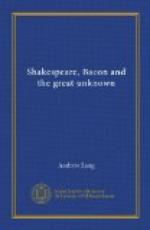It follows that we see the original monument and bust, but the painting is of 1861, for the bust, says Wheler, was in 1793 “painted in white,” to please Malone. It was repainted in 1861.
Mrs. Stopes, unluckily, is not content with what Hall was told to do, and what, according to Wheler, he did. She writes: “It would only be giving good value for his money” (12 pounds, 10s.) “to his churchwardens if Hall added (sic) a cloak, a pen, and manuscript.” He “could not help changing” the face, and so on.
Now it was physically impossible to add a cloak, a pen, and manuscript to such a stone bust as Dugdale’s man shows; to take away the cushion pressed to the stomach, and to alter the head. Mr. Hall, if he was to give us the present bust, had to make an entirely new bust, and, to give us the present monument in place of that shown in Dugdale’s print, had to construct an entirely new monument. Now Hall was a painter, not (like Giulio Romano) also an architect and sculptor. Pour tout potage he had but 12 pounds, 10s. He could not do, and he did not do these things! he did not destroy “the original monument” and make a new monument in Jacobean style. He was straitly ordered to “repair and beautify the original monument”; he did repair it, and repainted the colours. That is all. I do not quote what Halliwell-Phillipps tells us {183a} about the repairing of the forefinger and thumb of the right hand, and the pen; work which, he says, had to be renewed by William Roberts of Oxford in 1790. He gives no authority, and Baconians may say that he was hoaxed, or “lied with circumstance.”
Mr. Greenwood {183b} quotes Halliwell-Phillipps’s Works of Shakespeare (1853), in which he says that the design in Dugdale’s book “is evidently too inaccurate to be of any authority; the probability being that it was not taken from the monument itself.” Indeed the designer is so inaccurate that he gives the first word of the Latin inscription as “Judicyo,” just as Oudry blunders in the Latin inscription of a portrait of Mary Stuart which he copied badly. Mr. Greenwood proceeds: “In his Outlines Halliwell simply ignores Dugdale. His engraving was doubtless too inconvenient to be brought to public notice!” Here Halliwell is accused of suppressing




